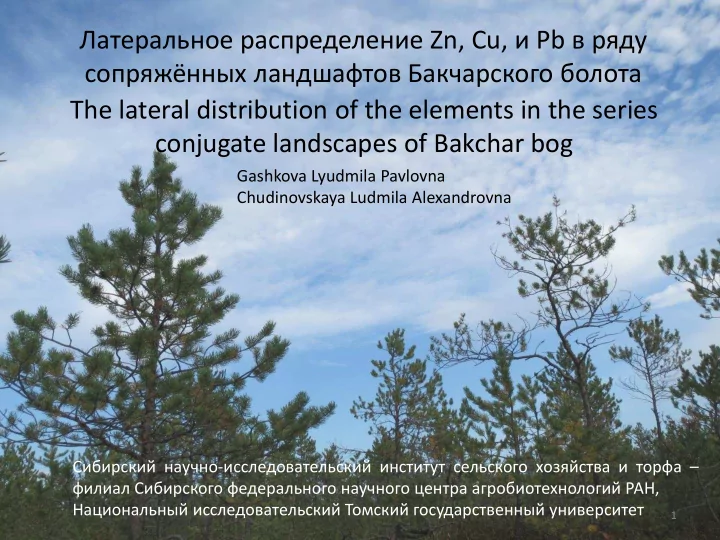

Латеральное распределение Zn, Cu, и Pb в ряду сопряжённых ландшафтов Бакчарского болота The lateral distribution of the elements in the series conjugate landscapes of Bakchar bog Gashkova Lyudmila Pavlovna Chudinovskaya Ludmila Alexandrovna Сибирский научно - исследовательский институт сельского хозяйства и торфа – филиал Сибирского федерального научного центра агробиотехнологий РАН, Национальный исследовательский Томский государственный университет 1
The spatial distribution of elements is determined by landscape-geochemical conditions. Particularly intensive are the anomalies of metals on geochemical barriers, one of which is the boundary of the forest and marsh, where the elements come in with surface and groundwater. The aim of the study is to compare the lateral distribution of elements in a series of conjugate landscapes. As the object, a bog in the interfluve of the rivers Bakchar and Iksa was chosen. Three key areas were investigated. 2
1 - swamp forest with a peat deposit capacity of 30 cm (56 ° 58''N 82 ° 36''E) 3
2 - pine-sedge-shrub-sphagnum bog with a thickness of peat deposit of 100 cm (56 ° 58''N 82 ° 36''E) 4
3 - pine-shrub-sphagnum bog, with a thickness of peat deposit of 250 cm (56 ° 58''N 82 ° 37''E) 5
The lateral differentiation of the content of elements in the conjugate series of elementary landscapes was considered based on our data on the concentration of Zn, Cu and Pb in plants and peat. The studies included landscape descriptions of sites, determination of the thickness of the peat deposit along the profile line using the georadiolocation method, sampling of the dominant and subdominant plants of each layer to determine the content of heavy metals. 6
The following species were selected: Pinus sibirica, Pinus sylvestris, Ledum palustre, Chamaedaphne calyculata, Rubus chamaemorus, Betula pubescens, Carex rostrata, Vaccinium uliginosum, and Sphagnum fuscum. To establish relationships between the main components of the geosystem, the features of the accumulation of heavy metals, geochemical coefficients were used: the coefficient of biological absorption (CBA), reflecting the ratio of the element's concentration in the plant's ash to its concentration in the soil (Ayvazyan, 1974); biogeochemical activity of species (BHA), which is the sum of the CBAs of the investigated elements (Perelman, Kasimov, 1999). 7
The content of Zn increases insignificantly in plants, while the concentration of this element in peat increases by about 4 times in the first section, in comparison with the second. The difference in Zn concentration in peat between the second and third patch is smaller, the content of the element increases 1.5 times in the second section, compared to the third. The content of Zn in plants 160 140 120 100 mg/kg 80 60 The content of Zn in peat 40 20 180 0 160 1 2 3 140 120 mg/kg 100 80 60 40 20 0 1 2 3 8
The concentration of Cu increases from the third to the second site by approximately 1.6 times in peat and 5 times in plants. In the first section, compared with the second, the content of Cu in plants increases 5-fold, and in peat more than 2-fold. The content of Cu in plants 4 3,5 3 2,5 mg/kg The content of Cu in peat 2 1,5 12 1 0,5 10 0 8 1 2 3 mg/kg 6 4 2 0 1 2 3 9
The concentration of Pb in plants and peat practically does not change in the second section, in comparison with the third. However, in the first section, compared with the second, the Pb content rises more than 4-fold for plants and 6-fold for peat. The content of Pb in plants 2,5 2 1,5 mg/kg 1 The content of Pb in peat 0,5 16 0 14 1 2 3 12 10 mg/kg 8 6 4 2 0 1 2 3 10
The coefficients of biological absorption of different elements vary unequally. The accumulation of Zn is most intense at the second (42) and third (39.6) sites, and least intensively at the first (12.9). The absorption activity of Cu is minimal at the third (0.7), and is approximately the same in the first (5.1) and second (4.9) sites. The biological absorption coefficient Pb is minimal in the first sites (2.8), and does not differ in the second (5.3) and third (5.5) sites. The coefficient of biological The coefficient of biological absorption of Pb absorption of Zn 7 60 6 50 5 40 4 30 3 20 2 1 10 0 0 1 2 3 1 2 3 The coefficient of biological 8 absorption of Cu 6 4 2 0 1 2 3 11
The biogeochemical activity of the species does not differ significantly in the second and third sites, and at the first it decreases more than 2 times. The biogeochemical activity of the species 160 140 120 100 80 60 40 20 0 1 2 3 12
Thus, as a result of the comparison, it was found that in the swamp forest, on the border of the forest and the bog, the content of the investigated elements was significantly increased, as compared with the neighboring sites of the mire. In addition, there is an increase in the concentration of Zn, Cu and Pb in plants and peat with a decrease in the thickness of the peat deposit. Biogeochemical activity of species, on the contrary, decreases in the site with a minimum thickness of the peat deposit, which is natural on the background of an increase in the content of elements in peat in the swamp forest site 13
Thank you for attention 14
Recommend
More recommend